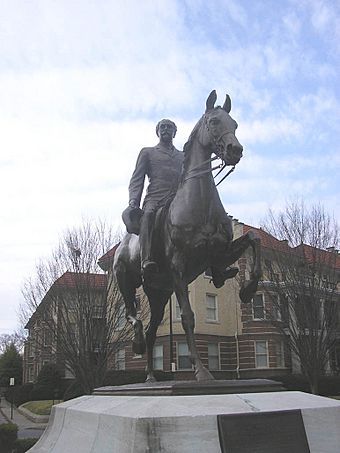John B. Castleman Monument facts for kids
Quick facts for kids |
|
|
John B. Castleman Monument
|
|
 |
|
| Lua error in Module:Location_map at line 420: attempt to index field 'wikibase' (a nil value). | |
| Location | Louisville, Kentucky |
|---|---|
| Built | 1913 |
| MPS | Civil War Monuments of Kentucky MPS |
| NRHP reference No. | 97000690 |
| Added to NRHP | July 17, 1997 |
The John B. Castleman Monument was a statue located in the Cherokee Triangle area of Louisville, Kentucky. It was first shown to the public on November 8, 1913. The statue was created by Roland Hinton Perry and cost $15,000, paid for by people who wanted to honor John Breckinridge Castleman.
The statue is made of bronze and stands on a granite base. It is 15 feet tall, with a base that is 12 by 20 feet. The monument was added to the National Register of Historic Places on July 17, 1997. Since 2019, there have been efforts to remove the statue because Castleman was a Major in the Confederate army. The monument was taken down on June 8, 2020. It is now being cleaned and will be moved to Castleman's burial site.
Contents
Who Was John B. Castleman?
John B. Castleman had an interesting life with many different roles. He was a soldier, a lawyer, and a community leader. He is perhaps best known for his work in creating Louisville's park system.
Castleman's Military Service
Castleman served as an officer during the American Civil War for the Confederate army. After the war, he became an officer in the U.S. Army, leading the Louisville Legion. He also fought in the Spanish–American War.
A historical marker near the statue once described his military past. It mentioned that he was part of "Morgan's men" and was imprisoned during the Civil War. He was later pardoned by President Johnson. He also served as a Brigadier General in Puerto Rico.
Castleman's Civilian Contributions
After his military service, Castleman studied law and became a lawyer. He graduated from the University of Louisville in 1868. He was very important to the city's growth and beauty.
Father of Louisville's Parks
Castleman is often called the "Father of the Louisville Park System." He worked hard to create many of the city's beautiful parks. He helped develop parks like Cherokee, Shawnee, Iroquois, and Central parks. He even donated land for Cherokee Park and sold part of his own property to help create Tyler Park.
It's important to know that Castleman worked to keep the parks open to everyone. Six years after he passed away, the parks became segregated. However, in 1924, many Black leaders in Louisville stated that Castleman "steadfastly refused to allow any kind of racial segregation in the parks of the city" while he was on the park board.
Horse Enthusiast
Castleman also loved horses. He started the American Saddlebred Horse Association and was its president for almost 25 years. The horse shown on the statue was based on his own beloved mare named Carolina. Castleman was often seen riding his five-gaited horse, either leading the Louisville Legion or working for the park system. This monument and the John Hunt Morgan Memorial in Lexington, Kentucky are the only Civil War monuments in Kentucky that show a person riding a horse.
Why Was the Statue Removed?
The John B. Castleman Monument became a topic of debate in Louisville. Many people felt that a statue honoring a Confederate officer did not represent the city's values.
Vandalism and Public Debate
The statue was vandalized several times with orange paint in 2017 and 2018. This led to a larger discussion about its place in the city. Louisville's Mayor Greg Fischer asked a committee to look into public artworks that might honor "bigotry, racism and/or slavery."
The committee suggested that removing such statues might be the best option. They felt that a statue "towering above a city street gives the impression that the city celebrates the entire life of the figure depicted." They also said that removal is best when a monument's message no longer matches the city's values.
The Decision to Remove
In August 2018, Mayor Fischer announced that the city would move the Castleman statue. This decision was based on the committee's findings. The city believed it should not keep statues that support racist or unfair ideas.
The Removal Process
Removing the statue was not a simple task. Because the statue was in a historic area, the mayor's office needed special permission. A local committee had a split vote on the issue in January 2019. However, in May 2019, the Metro Louisville Landmark Commission decided that the monument could be removed.
The removal was delayed for a while due to a lawsuit filed by some residents, historians, and a civil rights activist group. They argued that there were issues with the process. However, in June 2020, the statue was finally removed. It is now being cleaned and will be moved to Castleman's burial site in Cave Hill Cemetery.

